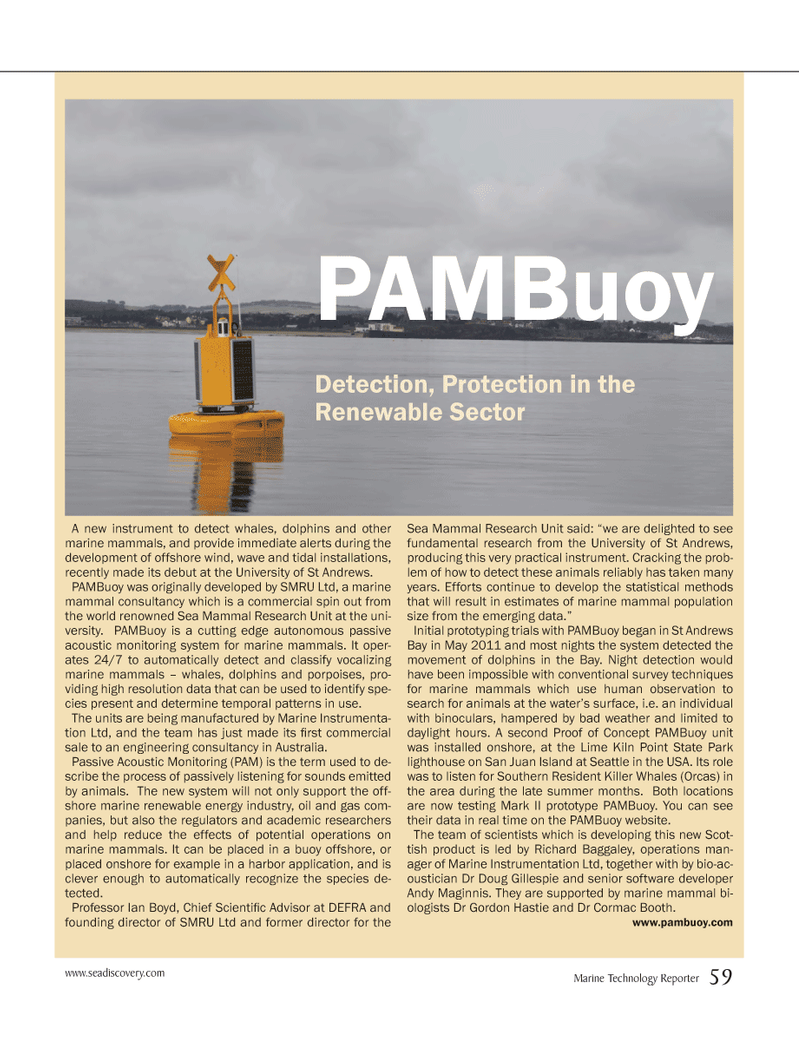
Page 59: of Marine Technology Magazine (October 2012)
Ocean Observation: Gliders, buoys & sub surface monitoring networks
Read this page in Pdf, Flash or Html5 edition of October 2012 Marine Technology Magazine
A new instrument to detect whales, dolphins and other marine mammals, and provide immediate alerts during the development of offshore wind, wave and tidal installations, recently made its debut at the University of St Andrews. PAMBuoy was originally developed by SMRU Ltd, a marine mammal consultancy which is a commercial spin out from the world renowned Sea Mammal Research Unit at the uni- versity. PAMBuoy is a cutting edge autonomous passive acoustic monitoring system for marine mammals. It oper- ates 24/7 to automatically detect and classify vocalizing marine mammals ? whales, dolphins and porpoises, pro- viding high resolution data that can be used to identify spe- cies present and determine temporal patterns in use. The units are being manufactured by Marine Instrumenta- tion Ltd, and the team has just made its Þ rst commercial sale to an engineering consultancy in Australia. Passive Acoustic Monitoring (PAM) is the term used to de- scribe the process of passively listening for sounds emitted by animals. The new system will not only support the off- shore marine renewable energy industry, oil and gas com- panies, but also the regulators and academic researchers and help reduce the effects of potential operations on marine mammals. It can be placed in a buoy offshore, or placed onshore for example in a harbor application, and is clever enough to automatically recognize the species de- tected. Professor Ian Boyd, Chief Scienti Þ c Advisor at DEFRA and founding director of SMRU Ltd and former director for the Sea Mammal Research Unit said: ?we are delighted to see fundamental research from the University of St Andrews, producing this very practical instrument. Cracking the prob- lem of how to detect these animals reliably has taken many years. Efforts continue to develop the statistical methods that will result in estimates of marine mammal population size from the emerging data.? Initial prototyping trials with PAMBuoy began in St Andrews Bay in May 2011 and most nights the system detected the movement of dolphins in the Bay. Night detection would have been impossible with conventional survey techniques for marine mammals which use human observation to search for animals at the water?s surface, i.e. an individual with binoculars, hampered by bad weather and limited to daylight hours. A second Proof of Concept PAMBuoy unit was installed onshore, at the Lime Kiln Point State Park lighthouse on San Juan Island at Seattle in the USA. Its role was to listen for Southern Resident Killer Whales (Orcas) in the area during the late summer months. Both locations are now testing Mark II prototype PAMBuoy. You can see their data in real time on the PAMBuoy website. The team of scientists which is developing this new Scot- tish product is led by Richard Baggaley, operations man- ager of Marine Instrumentation Ltd, together with by bio-ac- oustician Dr Doug Gillespie and senior software developer Andy Maginnis. They are supported by marine mammal bi- ologists Dr Gordon Hastie and Dr Cormac Booth. www.pambuoy.com PAMBuoy Detection, Protection in the Renewable Sector Marine Technology Reporter 59www.seadiscovery.com MTR #8 (50-64).indd 59MTR #8 (50-64).indd 5910/3/2012 2:45:02 PM10/3/2012 2:45:02 PM

 58
58

 60
60
